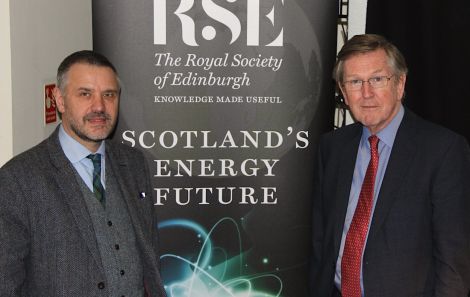News / Inquiry hears local views on energy issues
VIEWS on fuel poverty, local democracy issues, the difficulties of getting community energy projects off the ground and the lack of an informed debate on energy issues were all aired during a public meeting in the Shetland Museum on Wednesday night.
The Royal Society of Edinburgh had invited to a ‘call for evidence’ as part of the academic body’s inquiry into Scotland’s energy future.
Around 40 people followed the call and eventually engaged in an initially somewhat hesitant discussion on local energy issues.
As large delegations from both sides of the Viking wind farm debate had turned up it was only too obvious that no-one wanted to make a start on talking about the elephant in the room.
It was only when inquiry member professor Gavin Little asked a direct question about the planned interconnector and the prospect of large wind farm developments across Shetland that members of Sustainable Shetland expressed some of their misgivings.
These were no contributions from those representing wind farm interests.
The meeting kicked off with a short introduction by the inquiry chairman Sir Muir Russell in which he set out how the Royal Society wants to contribute to an informed debate on future energy issues.
While Scotland had set itself ambitious renewable energy targets and was in the fortunate position of boasting a wide spectrum of different energy resources, the fact was that 81 per cent of all energy consumed was still coming from fossil fuels, Russell said.
And although electricity was increasingly generated by renewables, it only counts for 22 per cent of Scotland’s overall energy consumption. By comparison, 53 per cent of energy is used on heat, and Scotland remains a net importer of energy.
Not surprisingly, the first contributions to the debate firmly focused on fuel poverty and the frustration felt by those working in the field.
Become a member of Shetland News
The council’s team leader of carbon management Mary Lisk said constantly changing government priorities made advocating energy saving measures to households and business anything but straightforward.
And Karen Eunson of the local Citizen’s Advice Bureau added that national measures, such as those on switching energy providers, often didn’t work locally.
She also said that fuel poverty shouldn’t be seen in isolation. The cost of having a decent stand of living is up to 30 per cent higher in Shetland than in the rest of Scotland.
“Energy reduction is not one of your priorities when you are suffering from poverty,” she said.
Former Fetlar development officer Robert Thomson then called for more support and less regulations to help community energy projects after speaking about obstacles he and his team had to overcome until they finally managed to get the go-ahead for a small wind to heat project on the island.
Prompted by inquiry member Gavin Little, Sustainable Shetland vice chairman James Mackenzie said the planned interconnector could lead to Shetland becoming an “offshore platform” for wind farm developments.
He added that campaign group’s concern expressed during the planning process for the Viking Energy wind farm had been “swept aside” because of national renewable energy targets and potential financial gain.
The owner of a small domestic wind turbine in Yell then expressed his frustration with the limitations of the local electricity grid as it could not accept any more renewable energy.
“I would like to see this as a green island, but I don’t see Shetland as a place covered in windmills,” he said.
Pointing out that he had no pressure group background, Lerwick resident John Waters said he regarded a cable link to mainland as “absolutely vital” while generally complaining about the poor standard of the energy debate, both nationally and locally.
Mary Lisk said it was high time that the community started discussing openly the use of community benefit funds and the money that will start flowing should the large wind farms proposed be built.
She said there was no debate at all as to what these community funds would be used for.
“What does the community want done with that money if it comes. We need to have that debate now,” she said.
Inquiry chairman Muir Russell said he was pleased with the engagement including the private meeting he and his team had with SIC officers on Wednesday afternoon.
“What was illuminating for us was to learn how the high level and fairly general propositions that come in this debate from government consultation and policy papers relate to the concrete and specific circumstances of a community like this where general answers won’t do,” he said.
Wednesday’s session was the second of five planned public engagements. Public meetings in Edinburgh, Glasgow and Aberdeen are to follow.
The inquiry is asking 15 consultations questions, which can be responded to until Friday 29 September. More information and contact details can be found at https://www.rse.org.uk/energyinquiry/
Become a member of Shetland News
Shetland News is asking its readers to consider paying for membership to get additional perks:
- Removal of third-party ads;
- Bookmark posts to read later;
- Exclusive curated weekly newsletter;
- Hide membership messages;
- Comments open for discussion.
If you appreciate what we do and feel strongly about impartial local journalism, then please become a member of Shetland News by either making a single payment, or setting up a monthly, quarterly or yearly subscription.




























































